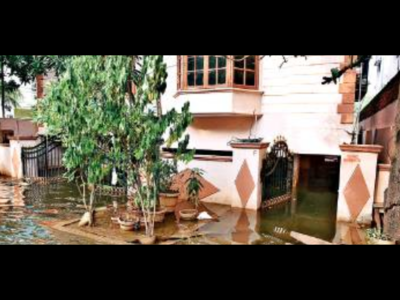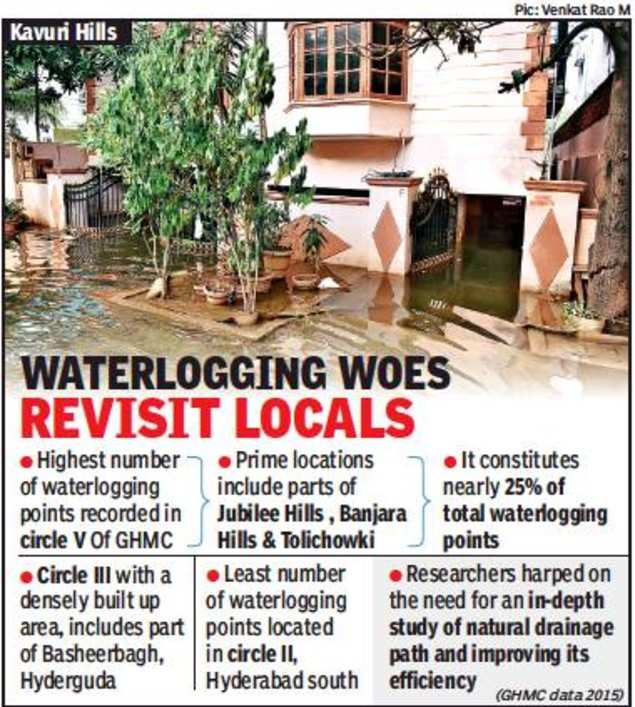The Times of India 23.10.2020

Kavuri HillsHYDERABAD:
While urban flooding leaves a trail of destruction, constant
waterlogging during rainy and non-rainy seasons in the city is always a
cause of concern for the authorities. Greater Hyderabad Municipal
Corporation’s (GHMC) 2015 data revealed that there are as many as 160
waterlogging points in its limits.
The highest number of
waterlogging points is located in circle V along the northwestern parts
of the city, which is characterised by hilly terrains as well as upscale
locations. This circle constitutes nearly 25% of the total waterlogging
points. The prime locations include parts of Jubilee Hills, Banjara
hills and Tolichowki.
waterlogging points is located in circle V along the northwestern parts
of the city, which is characterised by hilly terrains as well as upscale
locations. This circle constitutes nearly 25% of the total waterlogging
points. The prime locations include parts of Jubilee Hills, Banjara
hills and Tolichowki.

Interestingly,
the least number of waterlogging points are located in Hyderabad south,
which includes the historic core of the city.
the least number of waterlogging points are located in Hyderabad south,
which includes the historic core of the city.
Beyond the municipal corporation limits, in the peripheral areas of Greater Hyderabad, the highest number of waterlogging points is recorded in Secunderabad Cantonment area. “During non-rainy season, waterlogging occurrence is attributed to urban heat island
effect. Geo-tagging of waterlogging points can be taken up so that they
can be monitored on maps,” Venkateswarlu, who did research on water
stagnation in the city, said.
Experts said waterlogging is related
to improper maintenance of stormwater drains, catch pits and faulty road
engineering. “Unless these issues are addressed immediately, water
stagnation will be a constant problem,” they said. In 2005, then Municipal Corporation of Hyderabad (MCH) had come out with 30 reasons for rainwater stagnation in the city.
effect. Geo-tagging of waterlogging points can be taken up so that they
can be monitored on maps,” Venkateswarlu, who did research on water
stagnation in the city, said.
Experts said waterlogging is related
to improper maintenance of stormwater drains, catch pits and faulty road
engineering. “Unless these issues are addressed immediately, water
stagnation will be a constant problem,” they said. In 2005, then Municipal Corporation of Hyderabad (MCH) had come out with 30 reasons for rainwater stagnation in the city.
In
a study done by researchers, it was pointed out that the natural
drainage will have to be linked with sewer flow at appropriate stages.
It was also suggested a proper watershed management to ensure natural
percolation of rainwater and improve recharge of groundwater.
a study done by researchers, it was pointed out that the natural
drainage will have to be linked with sewer flow at appropriate stages.
It was also suggested a proper watershed management to ensure natural
percolation of rainwater and improve recharge of groundwater.
The
researchers also harped on the need for an in-depth study of natural
drainage path and improving its efficiency. They also proposed
establishment of run-off gauging stations to provide continuous reading
that can be used in designing stormwater drain capacity.
researchers also harped on the need for an in-depth study of natural
drainage path and improving its efficiency. They also proposed
establishment of run-off gauging stations to provide continuous reading
that can be used in designing stormwater drain capacity.
Apart from
setting up more catch pits, they suggested covering the stormwater
drains wherever they are uncovered and construction of retention walls.
setting up more catch pits, they suggested covering the stormwater
drains wherever they are uncovered and construction of retention walls.

